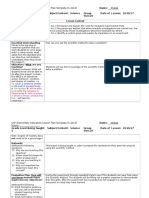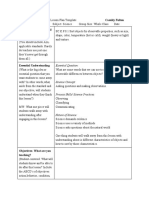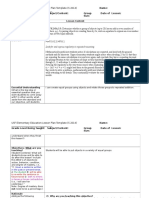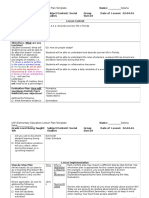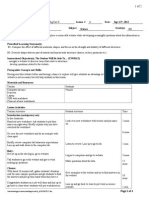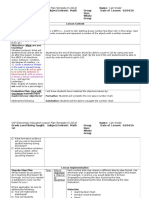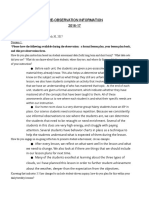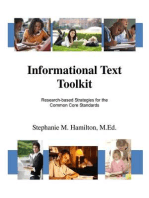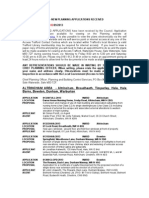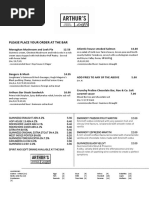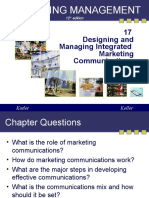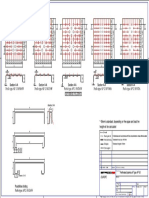USF Elementary Education Lesson Plan Template (S 2014) Schwarz
USF Elementary Education Lesson Plan Template (S 2014) Schwarz
Uploaded by
api-309598345Copyright:
Available Formats
USF Elementary Education Lesson Plan Template (S 2014) Schwarz
USF Elementary Education Lesson Plan Template (S 2014) Schwarz
Uploaded by
api-309598345Original Title
Copyright
Available Formats
Share this document
Did you find this document useful?
Is this content inappropriate?
Copyright:
Available Formats
USF Elementary Education Lesson Plan Template (S 2014) Schwarz
USF Elementary Education Lesson Plan Template (S 2014) Schwarz
Uploaded by
api-309598345Copyright:
Available Formats
USF Elementary Education Lesson Plan Template (S 2014)
Schwarz__________________________________
Grade Level Being Taught: Subject/Content: Science
3rd
Name: __Gabrielle
Group
Size:
Whole
Class
Date of Lesson: February
25, 2016
Lesson Content
What Standards (national
or state) relate to this
lesson?
(You should include ALL
applicable standards. Rarely
do teachers use just one:
theyd never get through
them all.)
Objectives- What are you
teaching?
(Student-centered: What will
students know and be able to
do after this lesson? Include
the ABCDs of objectives:
action, behavior, condition,
and degree of mastery, i.e.,
"C: Given a sentence written
in the past or present tense,
A: the student B: will be able
to re-write the sentence in
future tense D: with no errors
in tense or tense contradiction
(i.e., I will see her
yesterday.)."
Note: Degree of mastery does
not need to be a percentage.)
Evaluation Plan- How will
you know students have
mastered your objectives?
SC.3.L.14.1: Describe structures in plants and their roles in food production, support,
water and nutrient transport, and reproduction (CPALMS.org) .
Students will understand plants, the different parts of plants, and how those different
parts of the plants function together to create the end result.
Students will be able to work collaboratively with other classmates and conduct and
experiment.
Formative:
Walking around the classroom and noticing how students are working in their groups.
Taking notice of how the students are doing on their experiment. Are they conducting the
USF Elementary Education Lesson Plan Template (S 2014)
Schwarz__________________________________
Grade Level Being Taught: Subject/Content: Science
3rd
Name: __Gabrielle
Group
Size:
Whole
Class
Date of Lesson: February
25, 2016
Address the following:
What formative evidence
will you use to document
student learning during
this lesson?
What summative evidence
will you collect, either
during this lesson or in
upcoming lessons?
experiment correctly? Are they connecting it to what they have previously learned?
Summative:
Students observations and results they record in their science notebook.
Step-by-Step Plan
(What exactly do you plan to
do in teaching this lesson? Be
thorough. Act as if you needed
a substitute to carry out the
lesson for you.)
Time
Where applicable, be sure to
address the following:
How will materials be
distributed?
How will students
transition between
activities?
What will you as the
teacher do?
What will the students do?
What student data will be
5-10
min
Lesson Implementation
Who is
Each content area may require a different step-by-step format. Use
responsibl whichever plan is appropriate for the content taught in this lesson.
e (Teacher For example, in science, you would detail the 5 Es here
or
(Engage/Encountering the Idea; Exploring the Idea;
Students)? Explanation/Organizing the Idea; Extend/Applying the Idea;
Evaluation).
Teacher
Engage/Encountering the Idea: Introduction to the experiment; what
students will be doing; what their job is/ meeting up in groups/
distributing the material needed to conduct the experiment.
Exploring the Idea: Students will conduct the Science in a Snap:
Where does the Water go? experiment, will participate in their
groups how the colored water affects the flower, and how water
moves through a flower.
Explanation/Organizing the Idea: Students will be expected to write
down their ideas and results in their science notebook, as to be able
to reference their ideas and results again.
Applying the idea: Students will connect this experiment to what
USF Elementary Education Lesson Plan Template (S 2014)
Schwarz__________________________________
Grade Level Being Taught: Subject/Content: Science
3rd
collected during each
phase?
What are other adults in
the room doing? How are
they supporting students
learning?
What model of co-teaching
are you using?
Name: __Gabrielle
Group
Size:
Whole
Class
Date of Lesson: February
25, 2016
they are learning in class and to the main idea of how different parts
of a plant work.
Evaluation: I will be walking around the classroom while students
are doing the experiment, observing if everyone is participating and
how they are doing their experiment. I will look at the students
science notebooks after they complete the experiment in order to
get an idea of what they got or they learned from the experiment.
Meeting your students
needs as people and as
learners
If applicable, how does this lesson connect to the interests and cultural
backgrounds of your students?
This lesson is allowing students a hands-on learning experience where they are
actively learning and physically conducting an experiment.
Differentiationbased on
the needs of your students
how will you take
individual and group
learning differences into
account.
I will provide groups extra help in necessary, if students are unable to figure
out what they are supposed to be doing, I will try to lead students to a general
idea of what they are supposed to be doing.
Relevant Psychological
Theories and research
taken in consideration
when planning this lesson
I am connecting the idea of Critical thinking, which is something I learned about in my
learn and development class, to this lesson, students will not be able to simply
memorize information, they have to think about what they are doing, and why it is having
the effect it is on the flower. Why is the flower changing color? What does this mean is
happening?
You might also like
- Second Grade Science LessonDocument15 pagesSecond Grade Science Lessonlionheart10131333% (3)
- 5e Science Lesson PlanDocument10 pages5e Science Lesson Planapi-300269240No ratings yet
- Science Classification of Animals Lesson Plan 4 14Document8 pagesScience Classification of Animals Lesson Plan 4 14api-294619583No ratings yet
- Poverty LessonDocument3 pagesPoverty Lessonapi-272961940No ratings yet
- Name: - Gabrielle Grade Level Being Taught: 3rd Subject/Content: Math Group Size: Varies Date of Lesson: February 11, 2016Document3 pagesName: - Gabrielle Grade Level Being Taught: 3rd Subject/Content: Math Group Size: Varies Date of Lesson: February 11, 2016api-309598345No ratings yet
- USF Elementary Education Lesson Plan Template (S 2014) SchwarzDocument3 pagesUSF Elementary Education Lesson Plan Template (S 2014) Schwarzapi-309598345No ratings yet
- USF Elementary Education Lesson Plan Template (S 2014) SchwarzDocument3 pagesUSF Elementary Education Lesson Plan Template (S 2014) Schwarzapi-309598345No ratings yet
- Name: Nicole Liu - Grade Level Being Taught: 1st Subject/Content: Science/Conclusion Group Size: Whole Date of Lesson: 11/9/16Document8 pagesName: Nicole Liu - Grade Level Being Taught: 1st Subject/Content: Science/Conclusion Group Size: Whole Date of Lesson: 11/9/16api-295768366No ratings yet
- Save Fred Sup Lesson PlanDocument6 pagesSave Fred Sup Lesson Planapi-301531754No ratings yet
- USF Elementary Education Lesson Plan Template (S 2014) SchwarzDocument7 pagesUSF Elementary Education Lesson Plan Template (S 2014) Schwarzapi-309598345No ratings yet
- 4-11-16 Science Lesson Plan CT ObservationDocument3 pages4-11-16 Science Lesson Plan CT Observationapi-298011119No ratings yet
- USF Elementary Education Lesson Plan Template (S 2014) SenaDocument9 pagesUSF Elementary Education Lesson Plan Template (S 2014) Senaapi-295154683No ratings yet
- Science 5 ElessonplanDocument8 pagesScience 5 Elessonplanapi-340863506No ratings yet
- Name: Haleigh Dykes - Grade Level Being Taught: 4 Subject: Science Group Size: 24 Date of Lesson: April 12, 2017Document3 pagesName: Haleigh Dykes - Grade Level Being Taught: 4 Subject: Science Group Size: 24 Date of Lesson: April 12, 2017api-337051062No ratings yet
- Name: - Nicole Liu - Grade Level Being Taught: 1st Subject/Content: Science/Procedures & Materials Group Size: Whole Date of Lesson: 11/8/16Document8 pagesName: - Nicole Liu - Grade Level Being Taught: 1st Subject/Content: Science/Procedures & Materials Group Size: Whole Date of Lesson: 11/8/16api-295768366No ratings yet
- USF Elementary Education Lesson Plan Template (S 2014) SchwarzDocument7 pagesUSF Elementary Education Lesson Plan Template (S 2014) Schwarzapi-309598345No ratings yet
- Connected Inquiry Lesson PortfolioDocument17 pagesConnected Inquiry Lesson Portfolioapi-309448541No ratings yet
- Sorting Lesson PlanDocument4 pagesSorting Lesson Planapi-267077176No ratings yet
- USF Elementary Education Lesson Plan Template (S 2014) SchwarzDocument11 pagesUSF Elementary Education Lesson Plan Template (S 2014) Schwarzapi-309598345No ratings yet
- USF Elementary Education Lesson Plan Template (S 2014)Document7 pagesUSF Elementary Education Lesson Plan Template (S 2014)api-309598345No ratings yet
- Supervisor Lesson 1Document5 pagesSupervisor Lesson 1api-297259056No ratings yet
- Lesson PlanDocument5 pagesLesson Planapi-360396514No ratings yet
- Lesson Plan Template: Essential QuestionDocument4 pagesLesson Plan Template: Essential Questionapi-531359203No ratings yet
- Educ450 Lessonplan MTV Compass PointsDocument7 pagesEduc450 Lessonplan MTV Compass Pointsapi-295344110No ratings yet
- Rosa Parks Lesson PlanDocument6 pagesRosa Parks Lesson Planapi-265768556No ratings yet
- Ede4944 Connectedlessonus2Document7 pagesEde4944 Connectedlessonus2api-297176782No ratings yet
- Level 4 CT Lesson Plan 2Document9 pagesLevel 4 CT Lesson Plan 2api-333463707No ratings yet
- USF Elementary Education Lesson Plan Template (S 2014) SchwarzDocument7 pagesUSF Elementary Education Lesson Plan Template (S 2014) Schwarzapi-309598345No ratings yet
- USF Elementary Education Lesson Plan Template SenaDocument4 pagesUSF Elementary Education Lesson Plan Template Senaapi-295154683No ratings yet
- LVL 4 Supervisor Cycle 2 Lesson PlanDocument6 pagesLVL 4 Supervisor Cycle 2 Lesson Planapi-662674610No ratings yet
- Fractions Lesson Plan 2-08-2016Document3 pagesFractions Lesson Plan 2-08-2016api-298011119No ratings yet
- Greater Than or Less ThanDocument8 pagesGreater Than or Less Thanapi-276656028100% (1)
- The Basic Forms of EnergyDocument7 pagesThe Basic Forms of Energyapi-298329715No ratings yet
- Ede4941 Lessonplanone October1Document8 pagesEde4941 Lessonplanone October1api-297176782No ratings yet
- Supervisor Lesson 1Document10 pagesSupervisor Lesson 1api-267980163No ratings yet
- Edpr4100 Sciencesandslesson4sitesearchpart2Document4 pagesEdpr4100 Sciencesandslesson4sitesearchpart2api-252533855No ratings yet
- 2nd CT Observation LVL 4 Lesson Plan 22day The Rollets Got Their Moxie Back 22Document6 pages2nd CT Observation LVL 4 Lesson Plan 22day The Rollets Got Their Moxie Back 22api-662674610No ratings yet
- Usinger 621fieldform 2015 WriteDocument5 pagesUsinger 621fieldform 2015 Writeapi-310388263No ratings yet
- USF Elementary Education Lesson Plan Template (S 2014)Document7 pagesUSF Elementary Education Lesson Plan Template (S 2014)api-309598345No ratings yet
- CT Lesson ScienceDocument7 pagesCT Lesson Scienceapi-337799732No ratings yet
- USF Elementary Education Lesson Plan Template (S 2014) - Grade Level Being Taught: Subject/Content: Group SizeDocument9 pagesUSF Elementary Education Lesson Plan Template (S 2014) - Grade Level Being Taught: Subject/Content: Group Sizeapi-228765898No ratings yet
- Final Internship 1Document10 pagesFinal Internship 1api-295154683No ratings yet
- 1st Supervisor Observation Final InternDocument6 pages1st Supervisor Observation Final Internapi-662674610No ratings yet
- Lesson Plan 2 Algebra 2Document6 pagesLesson Plan 2 Algebra 2api-704050165No ratings yet
- Lesson Plan Jan 28Document4 pagesLesson Plan Jan 28api-297180060No ratings yet
- Inquiry (5E) Lesson Plan TemplateDocument3 pagesInquiry (5E) Lesson Plan Templateapi-487904244No ratings yet
- CT Observation 3Document7 pagesCT Observation 3api-298252147No ratings yet
- Observation 5 ScienceDocument6 pagesObservation 5 Scienceapi-346507216No ratings yet
- CT Observation On Simplest FormDocument8 pagesCT Observation On Simplest Formapi-298329715No ratings yet
- Lesson Plan S o 1Document4 pagesLesson Plan S o 1api-298704503No ratings yet
- CT Observation 2 Lesson PlanDocument6 pagesCT Observation 2 Lesson Planapi-376909408No ratings yet
- Matter Lesson 2-4Document10 pagesMatter Lesson 2-4api-266815194No ratings yet
- Lesson Plan Template Current Events 7th Grade Geography 2021Document4 pagesLesson Plan Template Current Events 7th Grade Geography 2021api-391016070No ratings yet
- CT Observation 2Document6 pagesCT Observation 2api-298252147No ratings yet
- Inquiry Based Lesson Plan Body Systems LabDocument3 pagesInquiry Based Lesson Plan Body Systems Labapi-436861773No ratings yet
- Sup Ob 3 Spring 17Document7 pagesSup Ob 3 Spring 17api-297180060No ratings yet
- Informational Text Toolkit: Research-based Strategies for the Common Core StandardsFrom EverandInformational Text Toolkit: Research-based Strategies for the Common Core StandardsNo ratings yet
- The Structured Method of Pedagogy: Effective Teaching in the Era of the New Mission for Public Education in the United StatesFrom EverandThe Structured Method of Pedagogy: Effective Teaching in the Era of the New Mission for Public Education in the United StatesNo ratings yet
- Blueprint For Thoughtful Lesson Planning: Excavating For Conceptual UnderstandingFrom EverandBlueprint For Thoughtful Lesson Planning: Excavating For Conceptual UnderstandingNo ratings yet
- MuseumexhibitprojectDocument1 pageMuseumexhibitprojectapi-309598345No ratings yet
- USF Elementary Education Lesson Plan Template (S 2014) SchwarzDocument7 pagesUSF Elementary Education Lesson Plan Template (S 2014) Schwarzapi-309598345No ratings yet
- USF Elementary Education Lesson Plan Template (S 2014) SchwarzDocument7 pagesUSF Elementary Education Lesson Plan Template (S 2014) Schwarzapi-309598345No ratings yet
- USF Elementary Education Lesson Plan Template (S 2014) SchwarzDocument7 pagesUSF Elementary Education Lesson Plan Template (S 2014) Schwarzapi-309598345No ratings yet
- USF Elementary Education Lesson Plan Template (S 2014) SchwarzDocument7 pagesUSF Elementary Education Lesson Plan Template (S 2014) Schwarzapi-309598345No ratings yet
- USF Elementary Education Lesson Plan Template (S 2014)Document7 pagesUSF Elementary Education Lesson Plan Template (S 2014)api-309598345No ratings yet
- ThreearticleblogDocument2 pagesThreearticleblogapi-309598345No ratings yet
- USF Elementary Education Lesson Plan Template (S 2014) SchwarzDocument7 pagesUSF Elementary Education Lesson Plan Template (S 2014) Schwarzapi-309598345No ratings yet
- USF Elementary Education Lesson Plan Template (S 2014) SchwarzDocument11 pagesUSF Elementary Education Lesson Plan Template (S 2014) Schwarzapi-309598345No ratings yet
- USF Elementary Education Lesson Plan Template (S 2014) SchwarzDocument7 pagesUSF Elementary Education Lesson Plan Template (S 2014) Schwarzapi-309598345No ratings yet
- USF Elementary Education Lesson Plan Template (S 2014)Document7 pagesUSF Elementary Education Lesson Plan Template (S 2014)api-309598345No ratings yet
- USF Elementary Education Lesson Plan Template (S 2014) SchwarzDocument7 pagesUSF Elementary Education Lesson Plan Template (S 2014) Schwarzapi-309598345No ratings yet
- (G.R. No. 122166. March 11, 1998) : Duty To Act With Justice, Honesty and GoodfaithDocument10 pages(G.R. No. 122166. March 11, 1998) : Duty To Act With Justice, Honesty and GoodfaithPierreNo ratings yet
- Plans List 2nd September 2013Document5 pagesPlans List 2nd September 2013SophieCorlessNo ratings yet
- Buchthal H. (1956) - The Beginnings of Manuscript Illumination in Norman SicilyDocument14 pagesBuchthal H. (1956) - The Beginnings of Manuscript Illumination in Norman SicilyКирилл ГлаватскихNo ratings yet
- Rizal Didnt RetractDocument6 pagesRizal Didnt RetractNicole BihagNo ratings yet
- History of Evolution TheoryDocument23 pagesHistory of Evolution Theorytricia onaNo ratings yet
- The Grand Tour - OverviewDocument20 pagesThe Grand Tour - Overviewangelapvargas2022No ratings yet
- Arthurs Bar Menu September 2022Document1 pageArthurs Bar Menu September 2022AlforrecawwwwwNo ratings yet
- Ebolavirus - Pathogen Safety Data Sheets PDFDocument8 pagesEbolavirus - Pathogen Safety Data Sheets PDFbrathe10No ratings yet
- Marketing Management: 17 Designing and Managing Integrated Marketing CommunicationsDocument36 pagesMarketing Management: 17 Designing and Managing Integrated Marketing CommunicationsMuhammad baqirNo ratings yet
- ReleaseNote PCE-AX58BTV1.0.0.6Document3 pagesReleaseNote PCE-AX58BTV1.0.0.6Sandip MaityNo ratings yet
- OPTIONAL Reading Practice - Interview Tips - English For Career Development Summer 2023Document7 pagesOPTIONAL Reading Practice - Interview Tips - English For Career Development Summer 2023Yamir VelazcoNo ratings yet
- Abstract_The Athletic Narratives and Career Development of StudentDocument2 pagesAbstract_The Athletic Narratives and Career Development of Studentwmzhang523No ratings yet
- Drawing+Perfo+Plank Staco Grating Technology Type+AP 30Document1 pageDrawing+Perfo+Plank Staco Grating Technology Type+AP 30Marwan HMNo ratings yet
- Ido-Guide (Ido-Guido) : For Doctors, Nurses, Stretcher-Bearers, The Wounded, The Sick, SoldiersDocument17 pagesIdo-Guide (Ido-Guido) : For Doctors, Nurses, Stretcher-Bearers, The Wounded, The Sick, SoldiersfelixespoNo ratings yet
- Iot Based Recycle Bin SystemDocument54 pagesIot Based Recycle Bin SystemThanesh ThaneshNo ratings yet
- Horizon Scanning in GovernmentDocument36 pagesHorizon Scanning in Governmentchorpharn4269No ratings yet
- Long Problem Paninindigan Kita CompanyDocument5 pagesLong Problem Paninindigan Kita CompanyHenrichNo ratings yet
- Being ULT EN 201810Document8 pagesBeing ULT EN 201810Edmar MirandaNo ratings yet
- RED COBRA Rubber Fire Hose Ver-270120Document1 pageRED COBRA Rubber Fire Hose Ver-270120fajar hidayahNo ratings yet
- CAMERADocument15 pagesCAMERALakshit Mittal100% (1)
- The Story of Ireland: A Bridge Between Celtic and Modern, America and EuropeDocument34 pagesThe Story of Ireland: A Bridge Between Celtic and Modern, America and EuropePriscila PimentelNo ratings yet
- Einstein's Cosmological Considerations: Daryl Janzen University of Saskatchewan, Saskatoon, CanadaDocument53 pagesEinstein's Cosmological Considerations: Daryl Janzen University of Saskatchewan, Saskatoon, Canadakakatsakis2No ratings yet
- Listening Unit 1Document5 pagesListening Unit 1Thuỳ Dương PhamNo ratings yet
- Daftar Kuantitas Harga Videotron KopassusDocument1 pageDaftar Kuantitas Harga Videotron Kopassusdimasdudut channelNo ratings yet
- MCOM 101 Intro Mass Comm ComprDocument176 pagesMCOM 101 Intro Mass Comm Comprmasterace42169No ratings yet
- Wa0000Document6 pagesWa0000pranjalchawla35No ratings yet
- Ebooks File Enhancing Couple Sexuality Creating An Intimate and Erotic Bond 1st Edition Mccarthy All ChaptersDocument62 pagesEbooks File Enhancing Couple Sexuality Creating An Intimate and Erotic Bond 1st Edition Mccarthy All Chaptersankudefortun100% (5)
- 4 13 PBDocument17 pages4 13 PBhebroniswell126No ratings yet
- Lesson 2.1 Magnetism Magnetic Field and Magnetic Forces PDFDocument82 pagesLesson 2.1 Magnetism Magnetic Field and Magnetic Forces PDFLance Adrian BengalanNo ratings yet
- Ingliz Tili 10 DarslikDocument224 pagesIngliz Tili 10 DarslikMiryunusov MirabbosNo ratings yet








